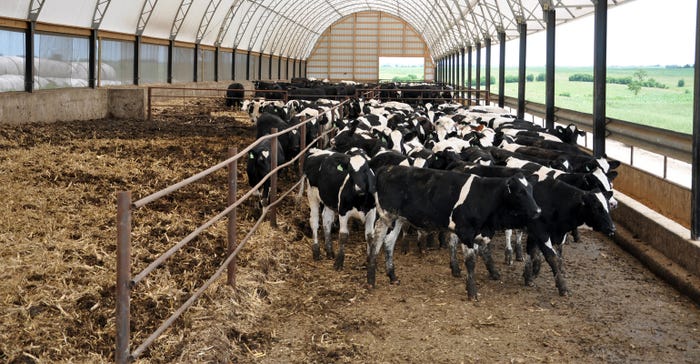August 29, 2017

Open feedlots, where livestock are exposed to the elements, are considered by many to be the cheapest way to run a concentrated animal feeding operation (CAFO), but they can also pose the greatest risk to the environment.
Many open feedlots sit on sloping landscapes, where manure may easily run off into streams, rivers or other waterbodies.
Even after installing a filter strip or sediment basin to slow runoff, pollution can occur during certain conditions, unless waste storage (total containment) is installed, says Christian Osborn, state conservation engineer with USDA’s Natural Resources Conservation Service.
For existing open feedlot owners, or those interested in raising livestock, Osborn says the local NRCS conservationist may recommend a roofed building option that totally contains manure as a viable option to better protect the environment and potentially enhance production.
Types of containment buildings
Mark Garrison, environmental engineer with NRCS in Iowa, says there are two basic types of covered, total containment buildings: bedded (solid manure) pack barns and deep pit (liquid manure) barns.
Bedded pack barns include metal roofed, timbered A-frames and steel framed monoslopes, or canvas covered hoop buildings. These buildings typically have concrete walls and floors, multiple bedded pens, a contained manure storage area, curtains for weather extremes, and feeding and watering areas.
A deep pit barn for liquid manure is roofed, similar to bedded pack barns, but they include a liquid manure storage area underneath a concrete slatted floor. Rather than scraping, livestock producers pump manure out of the deep pit when they are ready to use it.
Deep pit barns often cost more than bedded pack barns due to the additional cost of the concrete needed for the deep pit, says Garrison.

SAVE NUTRIENTS: Hoop buildings are a popular type of facility that keeps cattle comfortable with sunlight and a breeze. They also allow for easier manure management than an open feedlot.

Deciding between a bedded pack or a deep pit barn will depend on the producer’s personal and economic choice. For example, a producer may choose a bedded pack barn due to the lower risk of spills when handling solid manure.
Financial assistance available
Osborn says local NRCS staff are available to provide planning assistance to livestock producers, whether they are treating an existing feedlot with runoff containment or converting a feedlot to a confined roofed system. NRCS also offers financial assistance programs, such as the Environment Quality Incentives Program, which can help cut the cost of feedlot or confined waste management systems.
Producers interested in EQIP to address their CAFO concerns must complete a Comprehensive Nutrient Management Plan. A CNMP helps define the management and treatment practices necessary to address the resource concerns, and provide an operation and maintenance road map for the conservation practices installed.
For more information about open feedlot management, visit your local NRCS office or go to ia.nrcs.usda.gov.
Johnson is public affairs specialist with NRCS in Des Moines.
About the Author(s)
You May Also Like




